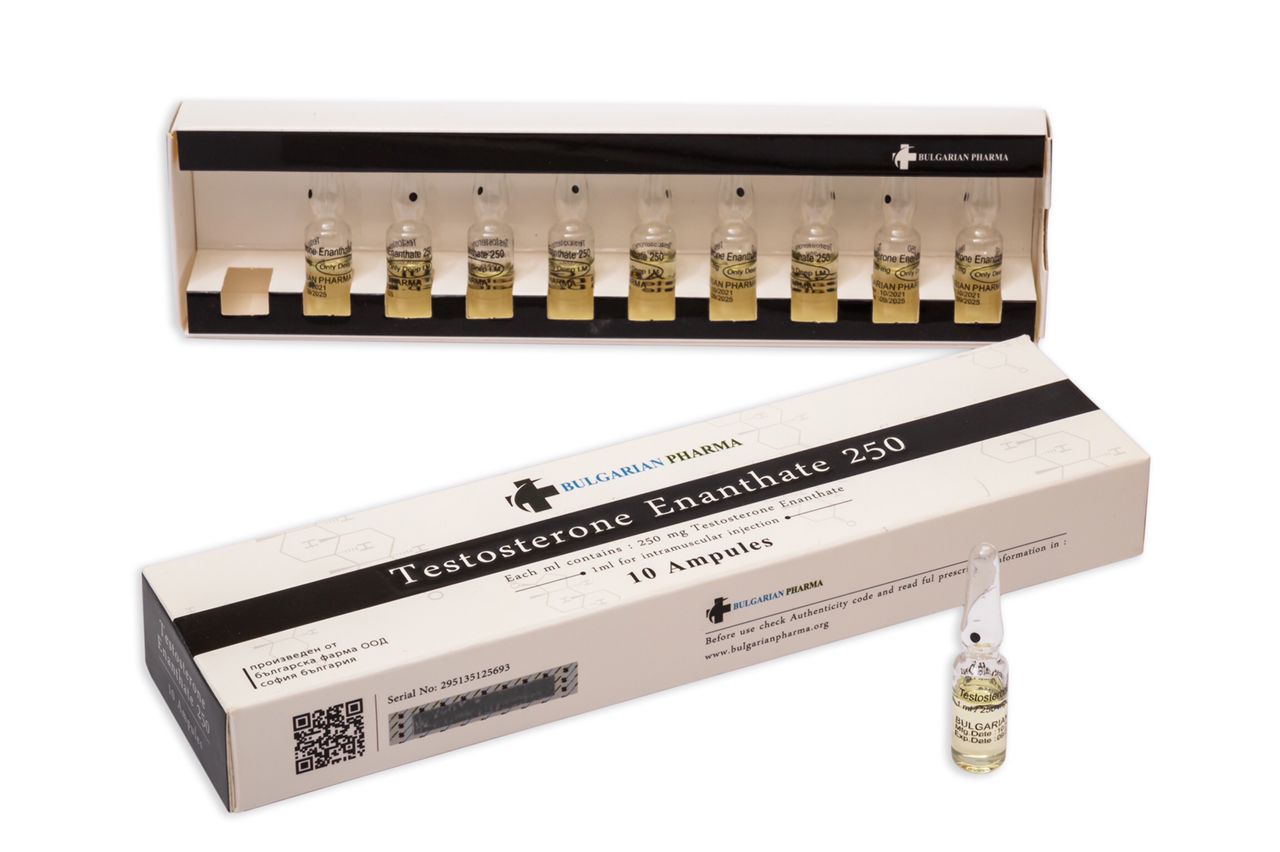Testosterone Enanthate 250
Active ingredients:Testosterone Enanthate Pharmacological category:Anabolic Steroid Composition:Every 1 ml contains 250 mg of Testosterone Enanthate in Ethyl oleate Mechanism of medicine action: Testosterone is the primary endogenous androgen. In their active form, all drugs in the class have a 17-beta-hydroxy group. Esterification of the 17-beta-hydroxy group produces com- pounds (Testosterone Enanthate and testosterone propionate) which have a longer duration of action and are hydrolyzed in vivo to free testosterone. Androgens are steroids that develop and maintain primary and secondary male sex characteristics. The effects of testosterone in humans and other vertebrates occur by way of two main mechanisms: by activation of the androgen receptor /directly or as DHT/, and by conversion to estradiol and activation of certain estrogen receptors. Free testosterone is transported into cytoplasm of target tissue cells, where it can bind to the androgen receptor, or can be reduced to 5-a di-hydrotestosterone by the cytoplasmic enzyme 5-alpha reductase. DHT binds to the same androgen receptor even more strongly than testosterone, so that its androgenic potency is about 5 times that of free testosterone. DHT-receptor complex under goes a structural change that allows it to move into the cell nucleus and bind directly to specific nucleotide sequences of the chromosomal DNA. The areas of binding are called hormone response elements, and influence transcriptional activity of certain genes, producing the androgen effects. Androgen receptors occur in many different vertebrate body system tissues, and both males and females respond similarly to similar levels. Greatly differing amounts of testosterone prenatally, at puberty, and throughout life account for a share of biological differences between males and females. Indications: Males: Testosterone Enanthate is indicated for replacement therapy in conditions associated with a deficiency or absence of endrogenous testosterone: Primary hypogonadism testicular failure due to cryptorchidism, bilateral torsion orchitis, vanishing testis syndrome, or orchidectomy. Hypogonadotropic hypogonadism idiopathic gonadotropin or LHRH deficiency, or pituitary-hypothalamic injury from tumors, trauma, or radiation. Testosterone Enanthate may be used to stimulate puberty in carefully selected males with clearly delayed puberty that is not secondary to a pathologic disorder. Females: Testosterone Enanthate may be used secondarily in women with advancing inoperable metastatic mammary cancer who are 1 to 5 years postmenopausal. Primary goals of therapy in these women include ablation of the ovaries. This treatment has also been used in premenopausal women with breast cancer who have benefited from ophorectomy and are considered to have a hormone responsive tumor. Contradictions: Testosterone Enanthate is contradicted in men with carcinomas of the breast or with known or suspected carcinomas of the prostate and in women who are or may become pregnant. When administered to pregnant women, androgens cause virilization of the external genitalia of the female fetus. The degree of masculinization is related to the amount of drug given and the age of the fetus and is most likely to occur in the female fetus when the drugs are given in the first trimester. If the patient becomes pregnant while taking these drugs, she should be apprised of the potential hazard of the fetus. Precautions: Women should be observed for signs of virilization (deepening of the voice, hirsutism, acne, clitoromegaly and menstrual irregularities). A decision may be made by the patient and the physician that some virilization will be tolerated during treatment for breast carcinoma.Because androgens may alter serum cholesterol concentration, caution should be used when administering these drugs to patients with a history of myocardial infarction or coronary artery disease. Drug interactions: Anticoagulants, Oxyphenbutazone, Insulin, ACTH and corticosteroids. Always take it under supervision by a physician Dosage: Dosage and duration of therapy with Testosterone Enanthate Injection will depend on age, sex, diagnosis, patient's response to treatment, and appearance of adverse effects. When properly given, injections of Testosterone Enanthate are well tolerated. Care should be taken to inject the preparation deeply into the gluteal muscle following the usual precautions for intramuscular administration. In general, total doses above 400 mg per month are not required because of the prolonged action of the preparation. Injections more frequently than every two weeks are rarely indicated. Males: As replacement therapy, i.e., for eunuchism, the suggested dosage is 50 to 400 mg every 2 to 4 weeks. Females: Palliation of Inoperable Mammary Cancer in Women: A dosage of 200 to 400 mg every 2 to 4 weeks is recommended. Women with metastatic breast carcinoma must be followed closely because androgen therapy occasionally appears to accelerate the disease. Parenteral drug products should be inspected visually for particulate matter and discoloration prior to administration, whenever the solution and container permit. Storage: Store in a dark, dry place, at room temperature. Do not refrigerate. Keep out of reach of children. Manufactured by: Bulgarian Pharma Ltd.


